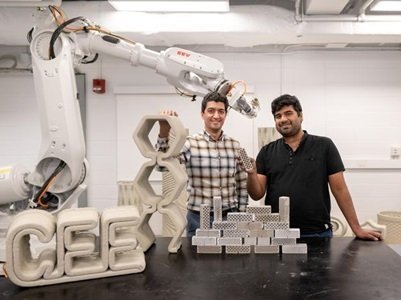Engineers at Princeton University have developed a cement-based material that surpasses conventional counterparts in damage resistance, thanks to inspiration drawn from the architecture of human bone.
This innovative approach has resulted in a material that is 5.6 times more damage-resistant than standard cement-based materials, showcasing a significant breakthrough in construction technology.

The research, published in the journal Advanced Materials, was led by Reza Moini, an assistant professor of civil and environmental engineering, and Shashank Gupta, a third-year Ph.D. candidate.
The team demonstrated that a cement paste with a unique tube-like architecture can resist cracking and avoid sudden failure, contrary to the behavior of traditional, brittle cement.
“One of the challenges in engineering brittle construction materials is that they fail in an abrupt, catastrophic fashion,” said Gupta.
This led the researchers to explore bio-inspired solutions, ultimately drawing parallels between the new cement design and the structure of human cortical bone.
Human cortical bone, which forms the dense outer layer of the femur, consists of elliptical tubular components known as osteons embedded in an organic matrix.
This architecture deflects cracks around osteons, enhancing fracture resistance. Similarly, the team incorporated cylindrical and elliptical tubes within the cement paste to interact with propagating cracks.
The ingenious design improves toughness by promoting crack-tube interactions, thereby preventing abrupt, catastrophic failure.
When a crack meets one of these tubes, it becomes trapped and delayed, dissipating energy that would otherwise lead to a faster crack propagation.
Moini emphasized the importance of internal architecture in this enhancement. “By taking advantage of the tube geometry, size, shape, and orientation, we can promote crack-tube interaction to enhance one property without sacrificing another,” Moini explained.
This stepwise toughening mechanism contrasts sharply with conventional methods of reinforcing cement, which often involves adding fibres or plastics.
Instead, the Princeton team’s approach relies solely on geometric design, manipulating the structure to achieve significant improvements in toughness.
Additionally, the researchers introduced a new method to quantify the degree of disorder within the material.
Based on statistical mechanics, this numerical framework offers a more nuanced representation of the material’s arrangements, transitioning from simple binary classifications to a spectrum ranging from ordered to random.
This approach enables the purposeful design of materials with a tailored degree of disorder, promising future scalability and application in civil infrastructure components using advanced fabrication methods like additive manufacturing.
“We’ve only begun to explore the possibilities,” noted Gupta. The team plans to continue investigating variables such as applying the degree of disorder to different sizes, shapes, and orientations of the tubes within the material.
These principles could potentially extend to other brittle materials, enhancing their damage resistance.
The study, titled Tough Cortical Bone-Inspired Tubular Architected Cement-Based Material with Disorder, opens new avenues for creating more resilient construction materials, potentially transforming the landscape of civil engineering.
